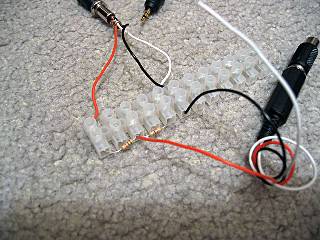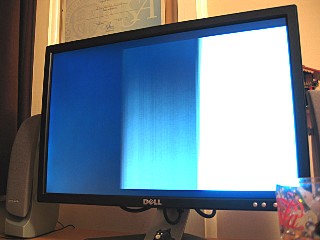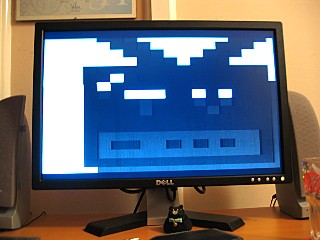Scripting
Wednesday, 21st November 2007
Scripting with .NET is unbelievably easy. ![]()
I wanted to add scripting support to Brass, and have added it using .NET's excellent powers of reflection and its System.CodeDom.Compiler namespace.
The first thing I need to do is find out which language the source script is written in. I use the extension to check for this.
string ScriptFile = ...; // Name of main script file to compile. CodeDomProvider Provider = null; // Get the extension (eg "cs") string Extension = Path.GetExtension(ScriptFile).ToLowerInvariant(); if (Extension.Length > 0 && Extension[0] == '.') Extension = Extension.Substring(1); // Hunt through all available compilers and dig out one with a matching extension. foreach (CompilerInfo Info in CodeDomProvider.GetAllCompilerInfo()) { if (Info.IsCodeDomProviderTypeValid) { CodeDomProvider TestProvider = Info.CreateProvider(); if (TestProvider.FileExtension.ToLowerInvariant() == Extension) { Provider = TestProvider; break; } } } if (Provider == null) throw new CompilerExpection(source, "Script language not supported.");
Now that we have a compiler, we just set some settings, add some references, then compile the source files:
string[] ScriptFiles = ...; // Array of source file name(s) to compile. // Compiler settings: CompilerParameters Parameters = new CompilerParameters(); Parameters.GenerateExecutable = false; // Class lib, not .exe Parameters.GenerateInMemory = true; // Add references: Parameters.ReferencedAssemblies.Add("System.dll"); Parameters.ReferencedAssemblies.Add("Brass.exe"); // Compile! CompilerResults Results = Provider.CompileAssemblyFromFile(Parameters, ScriptFiles);
And that's it! In my case I now pass any errors back up to the assembler, and exit if there were any errors:
// Errors? foreach (CompilerError Error in Results.Errors) { Compiler.NotificationEventArgs Notification = new Compiler.NotificationEventArgs(compiler, Error.ErrorText, Error.FileName, Error.Line); if (Error.IsWarning) { compiler.OnWarningRaised(Notification); } else { compiler.OnErrorRaised(Notification); } } // Do nothing if there were errors. if (Results.Errors.HasErrors) return;
Now the task is passed on to reflection; I go through the compiled assembly, hunt down methods and wrap them up for use as native Brass functions and/or directives.
// Grab the public classes from the script. foreach (Type T in Results.CompiledAssembly.GetExportedTypes()) { // ... }
I've used this technique in the release of my PAL demo; a C# script file is used to encode an image to the 18×304 resolution and format required by the routine.
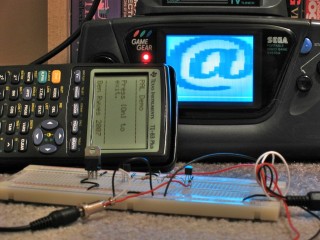
Brass 3 and software PAL
Wednesday, 14th November 2007
My work with the VDP in the Sega Master System made me more aware of how video signals are generated, so thought it would be an interesting exercise to try and generate them in software. This also gives me a chance to test Brass 3, by actively developing experimental programs.
I'm using a simple 2-bit DAC based on a voltage divider, using the values listed here. This way I can generate 0V (sync), ~0.3V (black), ~0.6V (grey) and 1V (white).
My first test was to output a horizontal sync pulse followed by black, grey, then white, counting clock cycles (based on a 6MHz CPU clock). That's 6 clock cycles per µs.
The fastest way to output data to hardware ports on the Z80 is the outi instruction, which loads a value from the address pointed to by hl, increments hl, decrements b and outputs the value to port c. This takes a rather whopping 16 clock cycles (directly outputting to an immediate port address takes 11 clock cycles, but the overhead comes from loading an immediate value into a which takes a further 7). The time spent creating the picture in PAL is 52µs, which is 312 clock cycles. That's 19.5 outi instructions, and by the time you've factored in the loop overhead that gives you a safe 18 pixel horizontal resolution - which is pretty terrible.
Even with this technique, in the best case scenario you output once every 16 clock cycles which gives you a maximum time resolution of 2.67µs. This is indeed a problem as vertical sync is achieved by transmitting two different types of sync pulse, made of either a 2µs sync followed by 30µs black (short) or 30µs sync followed by 2µs black (long). In my case I plumped for the easiest to time 4µs/28µs and hoped it would work.
Anyhow, I made a small three-colour image for testing: ![]() .
.
Of course, as I need to output each scanline anyway I end up with a resolution of 304 lines, which gives me rather irregular pixels, so I just stretch the above image up to 20×304. Eagle-eyed readers would have noticed that the horizontal resolution is only 18 pixels, but somewhere in the development process I forgot how to count and so made the image two pixels too wide.
As you can see, it shows (the entire image is shunted to the right). TVs crop the first and last few scanlines (they aren't wasted, though, and can be used for Teletext) so that's why that's missing. ![]() A widescreen monitor doesn't help the already heavily distorted pixels either, but it does (somewhat surprisingly) work.
A widescreen monitor doesn't help the already heavily distorted pixels either, but it does (somewhat surprisingly) work.
With a TI-83+ SE (or higher) you have access to a much faster CPU (15MHz) and more accurate timing (crystal timers rather than an RC circuit that changes speed based on battery levels) as well as better interrupt control, so on an SE calculator you could get at least double the horizontal resolution and output correct vertical sync patterns. You also have better control over the timer interrupts, so you could probably drive hsync via a fixed interrupt, leaving you space to insert a game (the only code I had space for checks to see if the On key is held so you can quit the program - more clock cycle counting). I only have the old 6MHz calculator, though, so I'm pleased enough that it works at all, even if the results are useless!
Brass 3.0.0.0 Beta 1
Monday, 5th November 2007
I've released a beta version of the new assembler. It comes with the compiler, a GUI builder (see the above screenshot) and the help viewer; it also comes bundled with a number of plugins.
I've also knocked together a quick demo project that can be built directly from Explorer once Brass is installed.
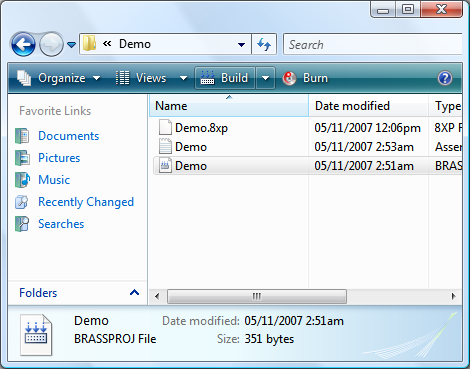
There are a number of missing features (such as a project editor, project templates and multiple build configurations) and no doubt broken, incomplete or untested components - but at least it's out in the wild now, which gives me an incentive to fix it!
